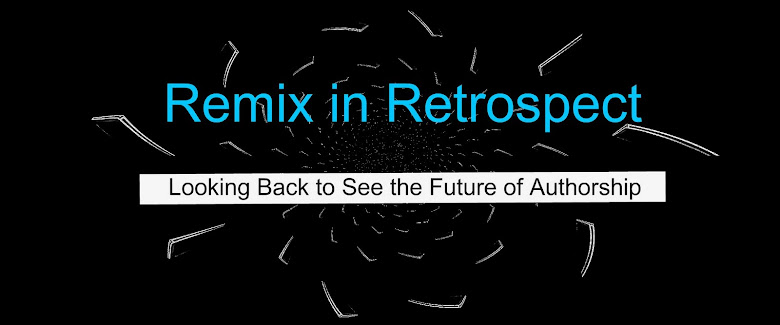I would like all speakers and members of the audience for making Remix in Retrospect such a marvellous and inspiring experience!
James Barrett kindly sent me his Prezi and the links to the videos he showed during his presentation ('Frankenstein's Monster Comes Home: Digital Remix and the Ends of Origin').
If any of the other speakers wishes to share (parts of) their presentations, do let me know!
About this blog
This blog accompanies the international symposium Remix in Retrospect: Looking Back to See the Future of Authorship, organized by the Faculty of Arts at VU University Amsterdam. Here, you will find information about the programme, the speakers and the abstracts. The basics:
Where: VU University, De Boelelaan 1105, Amsterdam, room 11A05
When: 21 October 2011, from 1PM to 6PM
Language: all papers and the discussion will be in English
Entrance: FREE
Registration: please send an email to Nelleke Moser: ph.moser@let.vu.nl
Thursday 27 October 2011
Monday 10 October 2011
Full Programme
SYMPOSIUM
Remix in Retrospect: Looking Back to See the Future of Authorship
21 October 2011
VU University Amsterdam
De Boelelaan 1105, Amsterdam
Main building, room 11A05
PROGRAMME
12.30-13.00 tea & coffee
13.00-13.15 welcome
13.40-14.05 Adam Smyth, Knives and Scissors: Cutting up Text in Early Modern England
14.05-14.30 Feike Dietz, Reading by Writing: Early Modern Reading Practices in Manuscript and Print Culture
14.30-15.00 tea & coffee
15.00-15.25 Kate Eichhorn, Late Print Culture’s ‘Social Media’ Revolution: Authorship, Collaboration and Copy Machines
15.25- 15.50 James Barrett, Frankenstein’s Monster Comes Home: Digital Remix and the Ends of Origin
15.50-16.15 Jenna Ng, Finders, Users, Up-enders; or, Authoring Media in the Digital Age: Mash-ups, Crowd-sourcing, Machinima
16.15-17.00 Round table discussion
How may knowledge of historical developments in manuscript and print culture feed the current debate on authorship, reading, copy-right, and creativity in the digital age? And how may a contemporary point of view help us understand and evaluate past practices?
17.00-17.10 closing remarks
17.10-18.30 drinks reception
Abstract of Adriaan van der Weel's paper
Sociotechnical construction of authorship
Prof. Dr. Adriaan van der Weel
Book and Digital Media Studies
Leiden University
Before the days of print, and thus before the days of commodification of authorship, there was a much less rigid distinction between textual production and its consumption than has become the case in the ‘Order of the Book’ that is now being challenged by digital developments. In the manuscript world, where few could read and write, literacy united author and reader more than the varying forms of their participation in the textual discourse divided them. It was normal, for example, for aspiring authors to appropriate existing texts through copying, imitating and emulating. In manuscript circulation the only difference between participants in the textual discourse was whether they copied or were copied, and if they were copied, how often. The decision to copy or not to copy can thus be constructed as a expression of reader power.
From the middle of the fifteenth century the technology of print proceeded to commodify authorship and, by imposing a system of rigidly one-way traffic, established a hierarchical relationship between author and reader (doubling as a prospective author). Publication in print also came to be regarded as formal recognition of authenticity, originality and social standing (as well as marketability), separating authors from readers.
By contrast, Web 2.0 returns textual discourse to the two-way, co-creative traffic of the manuscript age. This re-establishes a flat, horizontal relationship between author and reader, resulting in a loss of inhibition on the part of readers in using or appropriating authors’ work. There is, however, an important difference with the manuscript tradition in that in today’s Web world readers and writers are no longer part of an elite united through the relatively rare skill of literacy; instead there is, for the first time, mass participation in public textual production superseding a four-hundred year period of mass textual consumption.
Subscribe to:
Posts (Atom)
